
A Satire of the Three Estates, is a satirical morality play in Middle Scots, written by makar Sir David Lyndsay. The complete play was first performed outside in the playing field at Cupar, Fife in June 1552 during the Midsummer holiday, where the action took place under Castle Hill. It was subsequently performed in Edinburgh, also outdoors, in 1554. The full text was first printed in 1602 and extracts were copied into the Bannatyne Manuscript. The Satire is an attack on the Three Estates represented in the Parliament of Scotland – the clergy, lords and burgh representatives, symbolised by the characters Spiritualitie, Temporalitie and Merchant. The clergy come in for the strongest criticism. The work portrays the social tensions present at this pivotal moment in Scottish history.

"Robene and Makyne" is a short poem by the 15th-century Scottish makar Robert Henryson. It is an early example of Scottish pastourelle written in a form of ballad stanza and is almost unique of its kind. Very simple in structure and plot, yet highly compressed, multi-layered and open in its possible interpretations, it exemplifies Henryson's ability to combine complexity and restraint. The brevity and balanced structure of the poem creates effects that invite comparisons with music.

"The Taill of the Uponlandis Mous and the Burges Mous", also known as "The Twa Mice," is a Middle Scots adaptation of Aesop's Fable The Town Mouse and the Country Mouse by the Scottish poet Robert Henryson. Written around the 1480s, it is the second poem in Henryson's collection called The Morall Fabillis of Esope the Phrygian.
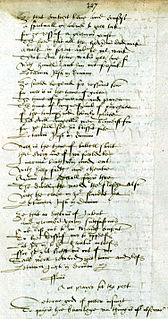
The Bannatyne Manuscript is an anthology of literature compiled in Scotland in the sixteenth century. It is an important source for the Scots poetry of the fifteenth and sixteenth centuries. The manuscript contains texts of the poems of the great makars, many anonymous Scots pieces and works by medieval English poets.

"The Taill of Schir Chanticleir and the Foxe" is Fabill 3 of Robert Henryson's cycle of thirteen Morall Fabillis composed in Scotland in the later fifteenth century. It is the first of the fable in the poem to be based on Reynardian and beast epic sources rather than on any strictly Aesopian original, although the closest match from Aesop might be The Dog, the Cock and the Fox.
William Stewart was a Scottish poet working in the first half of the 16th century.
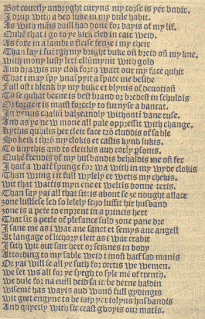
The Tua Mariit Wemen and the Wedo or The Tretis Of The Twa Mariit Wemen and the Wedo is a narrative poem in Scots by the makar William Dunbar. The title translates into English as The conversation of the two married women and the widow.
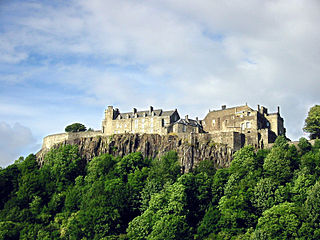
Ane Ballat of the Fenyeit Frier of Tungland, How He Fell in the Myre Fleand to Turkiland is a comic, satirical poem in Scots by William Dunbar composed in the early sixteenth century. The title may be rendered in modern English as A Ballad of The False Friar of Tongland, How He Fell in the Mire Flying to Turkey.

"Of Ane Blak-Moir" is a short poem in Scots by William Dunbar.

Meditatioun In Wyntir is a contemplative poem in Scots by William Dunbar.

The Dregy Of Dunbar also known as Dumbaris Dirige to the King is a humorous poem in Scots and Latin composed by William Dunbar. at an unknown date.

The Buke of the Howlat, often referred to simply as The Howlat, is a humorous 15th century Scots poem by Richard Holland.

"The Twa Cummeris", also rendered as "The Twa Cumeris", is a short humorous poem in Scots written at an unknown date by William Dunbar

Remonstrance to the King is a Scots poem of William Dunbar composed in the early sixteenth century. The Remonstrance is one of Dunbar's many appeals to his patron James IV of Scotland asking for personal advancement. In this particular case, the unseemly personal pleading is combined with more dignified subject matter; lavish praise and pointed criticism of the King's court is delivered in an open manner.

Quhy Sowld Nocht Allane Honorit Be is an anonymous allegorical poem of the fifteenth or sixteenth century written in Scots.
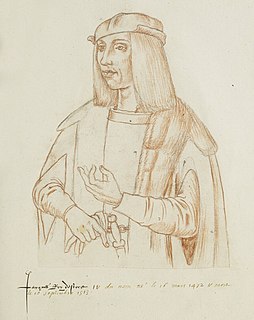
The Thrissil and the Rois is a Scots poem composed by William Dunbar to mark the wedding, in August 1503, of King James IV of Scotland to Princess Margaret Tudor of England.

He Is Na Dog, He Is A Lam is a poem by William Dunbar addressed to Queen Margaret Tudor of Scotland.
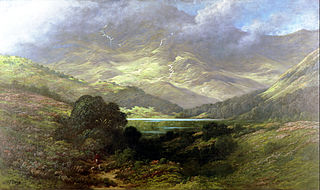
How The First Helandman of God Was Maid is an anonymous comic poem in Scots preserved in the Bannatyne Manuscript of the sixteenth century.
Ane New Yeir Gift to Quene Mary is a poem written by Alexander Scott (1520?-1582/1583) in 1562, as a New Year's gift to Mary, Queen of Scots. Mary had recently returned to Scotland from France following the death of her first husband, Francois II of France (d.1560). The poem was written in an effort to placate Mary's displeasure following her official reception into the City of Edinburgh organised by its burgh council in August 1561, at which Protestant imagery was highlighted. As a committed Catholic Mary had taken offence.
Ane Dance in the Quenis Chalmer or A dance in the Queen's chamber is a humorous or satiric Scots poem by William Dunbar.

















